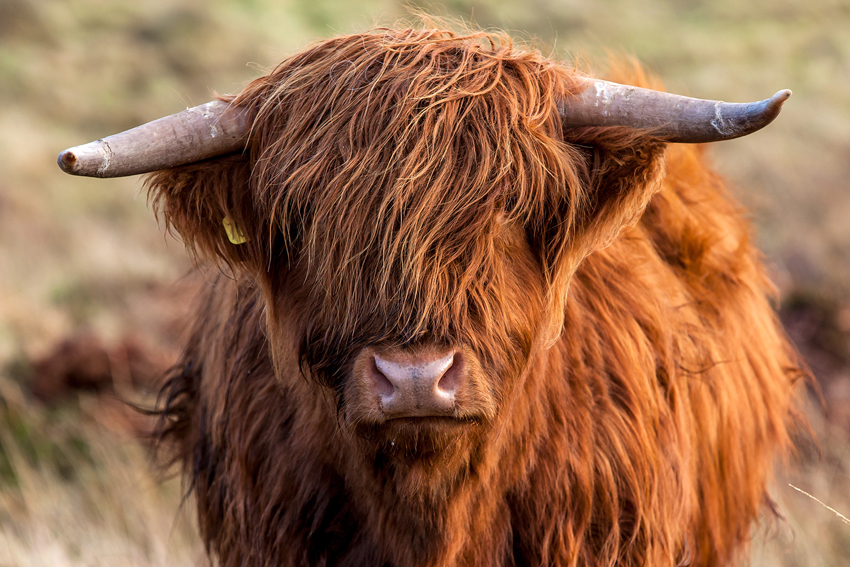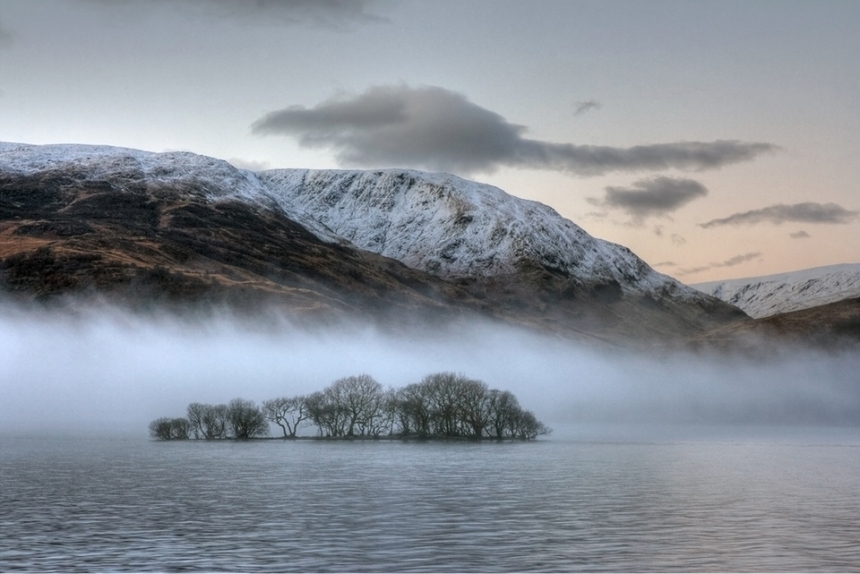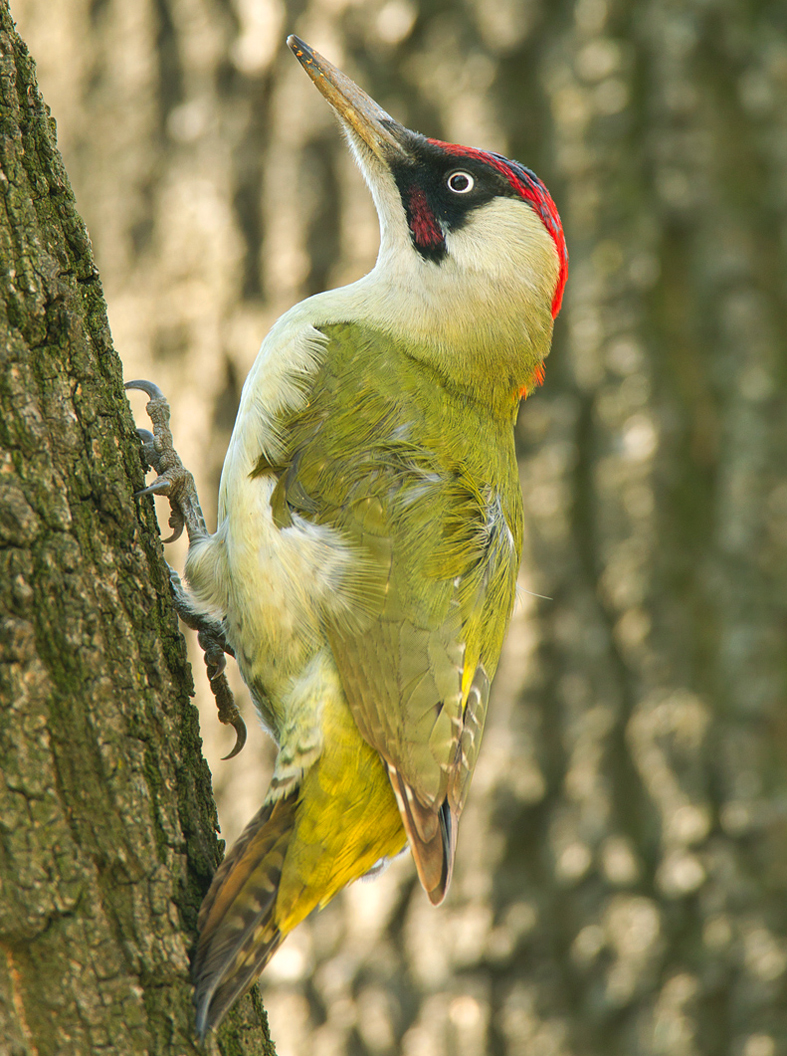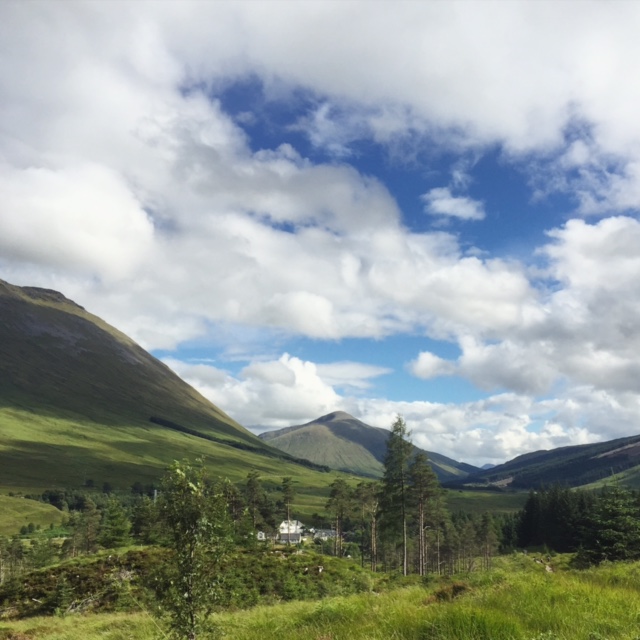Its time to tell you about my yarn colours! I’ve created seven new shades for Buachaille, and all have been inspired by different aspects of the landscape in which I live and love to walk: its flora, its fauna, and of course its weather.
Here’s what inspired Buchaille’s seven Scottish shades!
1. Highland Coo

These noble beasties are a true highland icon, and I have long been fascinated by the wonderful colours of their coats, which range from the palest caramel, through a deep russet, to a rich moorit brown. As I’m out walking, I frequently find myself picking up scraps and samples of coo hair which have been left behind on trees and fences, and wishing I had enough to spin up . . .I decided that dyeing some yarn was easier than shearing a coo. . . Highland Coo is a rich autumnal rusty-orange colour.
2. Haar

Living in Edinburgh for a decade, one became used to the haar – the cold mist that rolled in across the city from the North Sea. Haar – a particularly lovely Scots word – really captures the quality of Scottish mist: light and chill and softly hanging. Fog and mist lend the highlands their characteristic atmosphere, and make the rich colours of the landscape seem even more brilliant by contrast. Haar is a natural fleece shade, a light and airy silver-grey with lovely variegated tones.
3. Islay

The Western Isles abound with beautiful beaches, and to my mind there are few more beautiful than those on the isle of Islay. Here, enjoying a sunny day above Machir bay, the waves beat across the white sand, and the sea is a glorious shade of blue-green. Buachaille’s evocative and deeply saturated blue-green shade is named for Islay, the queen of the Hebrides.
4. Yaffle

The green woodpecker is perhaps more often heard than seen due to its call which lends the bird its popular name of “yaffle.” We’ve named one of our yarn shades yaffle after the plumage of this beautiful creature: a luminous and saturated mid-green with yellow tones.
5. Squall

A deep, dark, variegated grey is perhaps the most characteristic colour of the highlands. When I’m out walking close to home, and the sky turns this colour in the west, I can time the minutes to the moment I’m likely to get a soaking. Twenty minutes and counting. . . better get moving. Squall is a natural fleece shade, named for our stormy highland skies.
6. Ptarmigan

The ptarmigan is a kind of small grouse. It is a hardy highland bird, that has adapted to, and thrives in some truly challenging mountain conditions. In the summer, the ptarmigan’s brown and buff plumage camouflages it against the rocky landscape, and in the winter, it changes colour to a lovely creamy white, in order to blend in perfectly against the snow. With its beady eyes and fluffy feet, this bird is a real highland character, and Buachaille in its un-dyed, natural state is named for the ptarmigan in its winter plumage.
7. Between Weathers

Between weathers is an expression often heard in Scotland that refers to more than meteorology. Literally, it is that patch of blessed blue sky between one wet and windy front and another. But it also suggests the desire to seize the moment quickly, and to get on with things, when the day is fine. The weather must and will turn, so make haste, and make the most of that blue sky while it lasts. Between weathers is a rich mid-blue, the colour of the sky above Beinn Dorain at the top of the photograph above.
So there’s the palette: Highland Coo; Haar; Islay; Yaffle; Squall; Ptarmigan and Between Weathers. Developing these shades has been one of the most interesting (and heart-in-the-mouth) things I’ve ever done. I have found the process fascinating and am incredibly pleased with the results! In the next post I’ll tell you more about that process . . . and should also be able to show you some actual yarn
For those of you who have questions about the yarn, or who are having trouble pronouncing Buachaille, I’ve created a new FAQ page, which includes lots of sound files to help you!

How beautiful 💙
LikeLike
I understand Yaffle is originally a Suffolk word (where I am from)? So I’ve got to have that one. And haar to remind me of my 8 years in Edinburgh. .. I want them all just because of the names!
LikeLike
Like everyone else that has commented on your new adventure into your yarn creations I too am waiting with anticipation for your release. I wish you all the very best Kate.
LikeLike
Love the colours. Will the yarns be available in Ottawa Ont Canada? and will you be offering the pattern for the sweater that you wore on your wedding? It’s gorgeous!!!
LikeLike
Kate, I’ve always felt a connection to you in the Wild Knitting, and as you have entertained, educated and mostly inspired me through the last half-decade, I just can’t wait to get my hands on your yarn. I’ll never forget the first post which landed me to Needled blog, you had made a cap and testing colorwork with the Starmore yarn, and posted of your deep admiration of shades and yarn personality…and I was about to embark on one of my first colorwork pieces “Neepheid”. Thus we’ve come full-circle, myself designing now, and I am very hopeful to have a bundle of your yarns with which to design my own Northern California Highlands retrospective sort-of-thing in counterpart. Very proud of your journey,and so happy to have watched you come to this!
LikeLike
Those photo’s are truly breathtaking.. ! I am quite eager to see how it’s been translated into the yarns – probably stunning as well.
Now that you mentioned it though, I ám a bit curious what that coo’s hair would be like when spun and knit ;-)
LikeLike
Love this! Love the rich photography, the rich word play that brings to mind instantly the shade or colour you are describing. Cannot wait to see the yarn!
LikeLike
Kate the colors are lovely! I’m on my way to Scotland for a holiday. Will the yarn be on sale soon?
LikeLike
Thank you for sharing the entire “birthing” process of your upcoming yarn. From fleece scouring, to blending of wools to obtain just the right texture and quality, to color selection and naming — all fascinating. Everything you do, you do with such care and attention to detail. I hope that your yarn will be sold in North America, or that you will ship internationally. If so, I hope to be among the first customers!
LikeLike
Gorgeus Woodpecker, Higland Coo and Ptarmigan shots. Beautiful landscapes
LikeLike
What to say that hasn’t been said? The photos and the colors leave one thinking that if a trip to Scotland isn’t in the offing, this yarn promises to be the next best thing.
LikeLike
Absolutely fascinating!
LikeLike
What a thoughtful, passionate, beautiful, interesting exercise. I don’t knit, but I love colour. I am awaiting your launch in the hope that you might tempt me to take up some needles and learn.
LikeLike
Beautiful!
LikeLike
With an introduction like that, cannot wait to see the yard. A pleasure to read and lovely pictures too! Thank you, Kate.
LikeLike
Perfect inspirations for your yarn colors! So excited to see them in all their yarniness.
LikeLike
Very much looking forward to your yarn.
LikeLike
With names like Haar, Squall, and Between Weathers, I think I really need to buy some of this yarn to weave some scarves and cowls with.
LikeLike
Oh my goodness! Those look amazing! Way to go Kate!!!
LikeLike
Not that you don’t have your hands full at the moment ……. but if you ever wanted to offer cards or postcards of those photos, that would be amazing. :)
LikeLike
I love all your names and colors, may I suggest one addition? In the Gloaming: A hazy purple-blue with bits of yellow in it. It will be exciting to see your yarns for reals!
LikeLike
Wow; so beautiful inspirations for your yarn ♥ love the pictures
LikeLike
Thank you so much for walking us through this journey. The way you decided on the colors shows how much you love your environment and how well you know it, and it gives a new appreciation of nature and the beauty of the creation. I wish I had a yarn shop: I would order your yarn rightaway.,
LikeLike
The anticipation is killing me!
LikeLike
Beautiful! I love the thoughtfulness that has gone in to the making of this.
LikeLike
What an exciting start to the weekend. Cannot wait to see them for real!
LikeLike
Wonderful Country!
LikeLike
So exciting Kate! I can hardly wait to see and feel the yarn. And I love the Highland Coo!
LikeLike
I am so ready to see the yarn. Excited and inspired.
LikeLike
Although I follow your blog through email I only read about your new yarn today. What an exciting journey! Looking forward to meeting the yarn and I’m enjoying what I’ve seen and read this afternoon. Worsted spun too, I love that. Good luck!
LikeLike
Poetry!
LikeLike
Kate,
Your A writer at heart. After each of the 7 “Buachaille Colours”, I feel like somehow, I should be “Knitting a Story”. What that means, I’m not sure. It just seemed to want a knitting story to do it all justice. The only thing close that I can think of to relate, (but not exactly) is a scarf, that was popular about 4-5 years back. You started out with a white, a sky blue, a light and dark grey. Everyday you were to knit a row, in the colour that reflected the weather outside. Each was different, as different places had different weather. It was a bit fun actually, and the kids loved it. Now how does one incorporate a beautiful Scottish Yarn, into a pattern that will express it’s journey from Fleece, to a Yarn, that in and of itself is Scotland? Crazy, I know. It will naggle at me though! I can hardly wait to see each colour, although, I’m pretty sure that it’s Real Colour and Beauty won’t be seen, until “Buachaille” is in Hand!
LikeLike
So excited to see the new yarn! I will need all of the colors!
LikeLike
I am anticipating (champing at the bit) seeing the yarns, the actual colors soon in a blog post, but even more, I can’t wait to have them in my hands! Oh, and I am practicing with the sound files so I will be able tell people what it is I am knitting with.
LikeLike
Love the coo! I remember visiting my father’s uncle in the Hebrides when I was a young girl and the sights, sounds and mostly the colours have stayed with me all of my life. Among the many projects I am anticipating, is one of Lucy Hague’s Morvarch and I am hoping there will be perhaps eventually, an appropriate weight available. I think my Visa card is in big trouble.
LikeLike
Beautiful inspirational photo’s for those yarns.
In Dutch ‘haar’ means ‘hair’, nice name for a yarn :-).
LikeLike
You leave me feeling like a child in a candy store-and would love some of all of those. I am going to Scotland next Saturday and hopefully will see most of your inspirations. Can’t wait to have some highland coo skeins in my hand!
LikeLike
I like the way you are sharing all the steps, all the work involved it’s really interesting too see your creativity giving birth to your new colours.
LikeLike
That’s funny about the Curly Cows. My Dad used to call them Kylie Coos – possibly due to them being Kyloe cattle? I love them, but give them a wide berth on walks if there are young about.
I love the sound of both Islay and Yaffle – or maybe all of the colours! We fell in love with Islay last year, and when my daughter is home from Canada over Easter we have booked to stay again. (She missed out last time.)
LikeLike
Inspired.
LikeLike
A beautiful palette, Kate. I am so pleased that I have been so (relatively) good with my yarn purchases this year.
LikeLike
I love those colors and your explanations of the inspirations! Thank you for sharing.
LikeLike
Even though I have more yarn in my stash than I will ever knit in my lifetime, I’m just going to have to have some of this! It looks just beautiful.
LikeLike
Lovely shades! Not far from my house (I’m in Canada), there’s a farmer who has some Highland Coo’s (or some breed very similar). We refer to them as “Curly Cows” because of their beautiful coats
LikeLike
I agree with every comment in this post. I’m looking forward to see the yarn, and to know what size of needles is recommended. Love the colors and the names. I still can’t pronounce Buachaille, but I am sure I can find out how to order it :-) when times come.
LikeLike
Will the yarns be available in Canada, i.e., Calgary, Alberta?
Thank you,
Doris Fishman
LikeLike
Anticipation builds…
LikeLike
What a fabulous range of colours! It feels like attending the birth of something really exciting, can’t wait to see these colours in the flesh/skein/ball.
LikeLike
Can’t wait to see the yarns in their colored glory. The inspiration photo for Haar is breathtakingly stunning. If that’s yours, would you consider making it available as a print? I’d love to have it.
LikeLike
A truly exciting adventure. Looking forward to seeing the end result of wool and designs.
LikeLike
I love all these posts about the new yarn. Very interesting and inspiring processes. They do build quite an anticipation too. Can’t wait to see the yarn! :)
LikeLike
Beaufiful evocative names, lovely shades. Good thing winter is coming up…
LikeLike
Thank you so very much for all the beauty you share, in words, in pictures, in design, and now in yarn!
LikeLike
i need some of that highland coo and i have just the pattern in mind! lovely choices, kate!
tracey
LikeLike
Highland cows are super cute, it’s a pity they’re not so common :(
LikeLike
Your shades are both subtle and magnificent. Thank you for paying such good attention to your landscape.Thank you for posting your shades on my birthday, for color is about one of my most favorite things ever!
LikeLike
That sounds so promising. I am really curious how the colours will look like.
LikeLike
All of the colors & their stories are just perfect! The stories have given me ideas about what to make with each special color. It’s going to be a busy winter of knitting & it’s all your fault, Kate!
LikeLike
It was about time for the highland coo to be celebrated in yarn. I smile every time I se a photo of those beasties! I love colors described this way. A yarn shop owner in Georgia would do this very thing in order for me to fully understand the color. It sounds like a beautiful palette.
LikeLike
I LOVE the colour names of your yarns. How inspired and I can’t wait to get knitting with them. When will be able to get our hands on them?
LikeLike
These posts detailing the development of your yarn, its composition, colours, and the incredible processing are just wonderful Thank you so much.
LikeLike
Time to start saving my pennies! The colors are so like how you described them, glorious. It will take a lot of pennies to have some of all colors..
LikeLike
I finally understand why the woodpecker in Bagpuss was called Professor Yaffle!
LikeLike
So interesting reading about the process and inspirations, and you do take some truly beautiful photographs (I love your instagram feed, too). Although it’s hard not to take wonderful photographs in a landscape as beautiful as yours!
LikeLike
They all sound simply perfect!
LikeLike
Oh my goodness! I cannot wait to see the yarn! I’m sure it will be spectacular!
LikeLike
thanks for this lovely inspiration peek into your creative process. it make the colors live.
LikeLike
You are so adept at building the drama! You really had me with the last post; I think I was drooling when I saw the combed top! But now we have COLOR to imagine. And not just a palette you love, but one that is associated so intimately with parts of your world that mean a lot to you. Thank you….and I can’t wait!
LikeLike
I love all of those colours, and the stories are so evocative. Very excited to see the yarn!
LikeLike
Just too lovely, Kate! I find myself thinking that maybe my stash isn’t completely full, and maybe the UK is not that far away… What an amazing achievement this yarn is. Congratulations!
LikeLike
Gorgeous!
LikeLike
Bring on the yarn!!!! Can’t wait!!!! I’ve loved reading the evolution of the yarn and can’t wait to knit with it!
LikeLike
These are truly truly beautiful..i cannot believe how well you have managed to capture the Scotland I love…can these be posted to Canada?
LikeLike